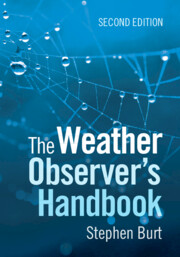Book contents
- The Weather Observer’s Handbook
- Reviews
- The Weather Observer’s Handbook
- Copyright page
- Dedication
- Epigraph
- Contents
- Foreword
- Acknowledgements
- Author’s note
- Abbreviations, footnotes and references
- Part I The basics
- Part II Measuring the weather
- Part III Making the most of your observations
- 17 Collecting and storing data
- 18 Making the data avalanche work for you
- 19 Sharing your observations
- 20 Summary and getting started
- Book part
- References and Further Reading
- Index
19 - Sharing your observations
from Part III - Making the most of your observations
Published online by Cambridge University Press: 21 May 2024
- The Weather Observer’s Handbook
- Reviews
- The Weather Observer’s Handbook
- Copyright page
- Dedication
- Epigraph
- Contents
- Foreword
- Acknowledgements
- Author’s note
- Abbreviations, footnotes and references
- Part I The basics
- Part II Measuring the weather
- Part III Making the most of your observations
- 17 Collecting and storing data
- 18 Making the data avalanche work for you
- 19 Sharing your observations
- 20 Summary and getting started
- Book part
- References and Further Reading
- Index
Summary
Weather knows no boundaries. Interest in ‘measuring the weather’ at any particular location is greatly enhanced by exchange and comparison of observations with others – locally/regionally, nationally or internationally. This chapter suggests ways to exchange information with other sites and other observers, under three main headings – online or real-time sharing using the Internet, online or offline reporting to informal or voluntary networks and co-operation with national weather services and other official bodies.
Keywords
- Type
- Chapter
- Information
- The Weather Observer's Handbook , pp. 410 - 425Publisher: Cambridge University PressPrint publication year: 2024

